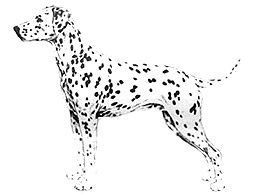Breed standards
Dalmatian
Breed standards are the official guidelines that describe the ideal characteristics, temperament, and appearance of a breed and ensures that the breed is fit for function with soundness essential.

Pre 1987 Kennel Club, London
The Dalmatian should be a balanced, strong, muscular, active dog of good demeanour. Symmetrical in outline, free from coarseness and lumber, capable of great endurance with a fair amount of speed.
(See under General Appearance and Colour.)
Of good demeanour.
The head should be of fair length, the skull flat, reasonably broad between the ears but refined, moderately well defined at the temples, i.e. exhibiting a moderate amount of stop; not in one straight line from nose to occiput bone. Entirely free from wrinkle. The muzzle should be long and powerful, never snipy, the lips clean. fitting the jaw moderately close. The nose in the black spotted variety should always be black, in the liver spotted variety always brown.
The eyes, set moderately well apart, should be of medium size, round, bright and sparkling, with an intelligent expression, their colour, depending on the marking of the dog; dark in the black spotted, amber in the liver spotted. The rim round the eyes should be complete; black in the black spotted and liver brown in the liver spotted.
The ears should be set on rather high, of moderate size, rather wide at the base, gradually tapering to a rounded point. Fine in texture, carried close to head. The markings should be well broken up, preferably spotted.
The teeth should meet. The upper slightly overlapping the lower (scissor bite).
The neck should be fairly long, nicely arched, light and tapering. Entirely free from throatiness.
The shoulders should be moderately oblique, clean and muscular. Elbows close to the body. The forelegs perfectly straight with strong round bone down to the feet, with a slight spring at the pastern joint.
The chest should not be too wide but deep and capacious with plenty of lung and heart room. The ribs well sprung, well defined wither, powerful level back, loins strong, clean and muscular, and slightly arched.
Rounded, muscles clean with well developed second thigh, good turn of stifle and hocks well defined.
Round, compact, with well arched toes (cat-feet) and round tough elastic pads. Nails black or white in the black spotted variety, in the liver spotted - brown or white.
In length reaching approximately to the hocks. Strong at the insertion gradually tapering towards the end, it should not be inserted too low or too high, be free from coarseness and carried with a slight upward curve, never curled. Preferably spotted.
The Dalmatian should have great freedom of movement. A smooth, powerful rhythmic action with a long stride. Viewed from behind, the legs should move in parallel, the hindlegs tracking the fore. A short stride and paddling action is incorrect.
The coat should be short, hard and dense, sleek and glossy in appearance.
The ground colour should be pure white. Black spotted dogs have dense black spots and liver spotted dogs liver-brown spots. They should not run together but be round and well defined, the size of a FIVE to a TWENTY CENT COIN, as well distributed as possible. Spots on the extremities should be smaller than those on the body.
Overall balance of prime importance, but the ideal height to be aimed at is:
Dogs 58-61 cms (23-24 ins.),
Bitches 56-58 cms (22-23 ins.).
Any departure from the foregoing points should be considered a fault and the seriousness with which the fault should be regarded should be in exact proportion to its degree and its effect upon the health and welfare of the dog.
Blue eyes.
Patches. Black and liver spots on the same dog (tricolours).
Lemon spots. Bronzing and other faults of pigmentation.
Male animals should have two apparently normal testicles fully descended into the scrotum.



